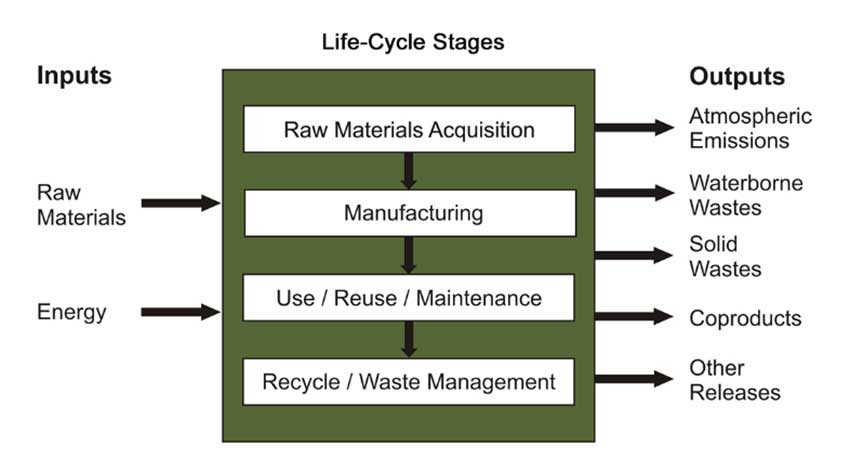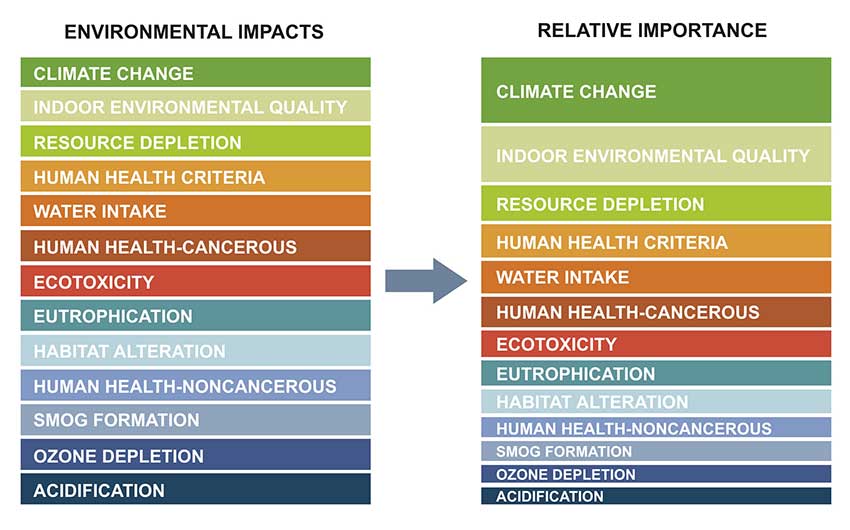Concrete Impacts
Learning Objectives:
- Recognize how concrete can reduce the life-cycle impacts of a building.
- Define life-cycle assessment (LCA) and explain how it can be used to help measure and reduce the environmental impacts of a building.
- Discuss how LCA is used in the green building standards.
- Describe an example of how LCA software tools can be used to reduce the environmental impact of a building, including carbon footprint,0920026003 GBCI
Credits:
This course is approved as a Structured Course
This course can be self-reported to the AANB, as per their CE Guidelines
Approved for structured learning
Approved for Core Learning
This course can be self-reported to the NLAA
Course may qualify for Learning Hours with NWTAA
Course eligible for OAA Learning Hours
This course is approved as a core course
This course can be self-reported for Learning Units to the Architectural Institute of British Columbia
When looking at the environmental impact of a building, it is important to assess every stage of the environmental life cycle, from material extraction and product manufacturing to building operations and maintenance through to end-of-life. Concrete offers many environmental attributes that help reduce the overall environmental life-cycle impacts of a building. This course explores how life-cycle assessment can be used to measure and lower the environmental impacts of buildings, including carbon footprint.

NRMCA Skanska USA Commercial Development, Inc.
Capitol Tower, Houston, TX. This 35-story, 750,000-square-foot, Class A office building features concrete pan-formed beams with post-tensioned girders, a mat foundation, and concrete core/shear walls. Developer: Skanska. Architect: Gensler; Structural Engineer: Walter P. Moore
Life-Cycle Assessment and Concrete
Architects are increasingly interested in reducing the environmental impact of the buildings they design—and for good reason. Buildings account for nearly 40 percent of C02 emissions. C02 emissions are directly responsible for climate change, which we now know will continue to have far-reaching negative impacts if no action is taken. To mitigate climate change, the latest Intergovernmental Panel on Climate Change (IPCC) report states that global warming needs to be limited to 2.7°F (1.5°C). That goal, the report says, requires a “rapid and far-reaching” transition in land, energy, industry, buildings, transport, and cities. The climate change message can often feel dire, but, in fact, it is one of great opportunity: with the right tools and approach, the built environment can go from being a major contributor to climate change to becoming a leader in innovative solutions.
Of the annual emissions buildings emit, 28 percent are due to building operations, while emissions from building materials and construction (referred to as embodied carbon) are responsible for an additional 11 percent annually. Unlike operational carbon emissions, which can be reduced over time with building energy upgrades and the use of renewable energy, embodied carbon emissions are locked into place as soon as a building is built. For this reason, it is essential to predict emissions and reduce carbon impacts from the beginning of a building project. Architect 2030, a nonpartisan, nonprofit organization working to rapidly transform the built environment from emitter to climate solver, states on its website that getting a handle on embodied carbon now will help the U.S. hit the net-zero emissions goals of the Paris Climate Accord by 2050 and aid in moving the world toward a better climate future.
In conjunction with climate change, new construction is on the rise, which means assessment tools for embodied carbon are more important than ever. Achieving net-zero embodied emissions will require adopting three principles: reuse, reduce, and sequester. Reusing includes renovating existing buildings, using recycled materials, and designing for deconstruction. Reducing includes material optimization and specification of low- to zero-carbon materials and sequestering means looking for opportunities to use carbon-sequestering materials. Three materials—concrete, steel, and aluminum—are responsible for 23 percent of total global emissions, mostly used in the built environment. This is where the opportunities arise and the solutions must take place. In this article, we’re going to focus on the opportunities when it comes to assessing concrete.
The Environmental Benefits of Concrete
Concrete offers several environmental benefits that can help reduce the overall impact of a building. For example, the production of concrete is resource-efficient, and the ingredients require little processing. Most materials for concrete are acquired and manufactured locally, which minimizes transportation energy and associated greenhouse gas emissions. Concrete incorporates recycled industrial byproducts such as fly ash, slag, and silica fume, which helps reduce embodied energy, carbon footprint, and landfill disposal. Concrete also has a long service life, thereby decreasing reconstruction, repair, and maintenance and associated environmental impacts.

Figure 2: Life-cycle stages, inputs, and outputs for life-cycle assessment (adapted from USEPA).
Most importantly, because of concrete’s thermal mass, concrete buildings can be extremely energy-efficient. From a life-cycle perspective, concrete buildings perform well when compared to steel- and wood-frame buildings. As a result, concrete buildings have lower carbon footprint over their entire life cycle. This paper explores how life-cycle assessment (LCA) methods can be used to quantify and improve the environmental performance of a building.
What is Life-Cycle Assessment?
LCA is the investigation and evaluation of the environmental impacts of a product, process, or service. It is one of the best mechanisms for allowing architects and other building professionals to understand the energy use and other environmental impacts associated with all the phases of a building’s life cycle: procurement, construction, operation, and decommissioning. LCA evaluates all stages of a product’s life and considers each stage interdependently. There are several inputs, life-cycle stages, and outputs as shown in Figure 2.
Inputs include raw materials and energy. The output of an LCA can be thought of as a wide-ranging environmental footprint of a building. They include emissions, waterborne wastes, solid wastes, co-products, and other releases. These outputs are then converted to potential environmental impacts based on scientific knowledge of how these outputs affect the planet, ecosystems, and human health.
One environmental impact tool developed by the United States Environmental Protection Agency (EPA) is called the Tool for the Reduction and Assessment of Chemical and Other Environmental Impacts (TRACI). TRACI allows the examination of impacts associated with the raw material usage and energy consumption (inputs) and chemical releases (outputs) resulting from the processes involved in producing a product or, in this case, construction and operation of a building over a specific lifetime.
These environmental impacts include ozone depletion, global warming, acidification, eutrophication, photochemical smog, human health issues, ecotoxicity, fossil fuel use, land use, and water use, among others.

Image courtesy of NRMCA
Figure 4: Environmental impacts and relative importance of impacts (adapted from USGBC).
Figure 3 provides a schematic representation of potential environmental impacts, and one possible interpretation of their relative importance, for the purpose of identifying the most critical impacts. The relative importance of each impact might change depending on the product or process being analyzed or on other factors such as location and/or political influences. For example, many governments have declared climate change as today’s most important environmental impact. However, there are some locations where water is scarce and therefore water intake and waterborne releases may be a more immediate priority.
Assessing every stage of the environmental life cycle is essential to providing a comprehensive whole-building picture, and it allows designers and engineers to make decisions early in the process, resulting in lower total environmental impacts.
With so many inputs and outputs and associated environmental impacts for each life cycle, the whole-building picture is complex. For a building, energy and materials are consumed to manufacture building products, resulting in environmental releases and associated impacts. Impacts of transporting raw materials to the manufacturing facility and from the manufacturing facility to the construction site must also be accounted for. Similarly, there are inputs and environmental releases from the construction stage. The use or operational life-cycle stage impacts are significantly greater than those in the other life-cycle stages. A building usually operates for decades, consuming energy and raw materials with associated environmental releases. These operational stage impacts typically dwarf the environmental impacts from material extraction, manufacturing, and end-of-life stages for commercial and residential buildings.
The major hurdle to adopting LCA as a tool for evaluating and improving the environmental impacts of buildings has been the lack of data. Product manufacturers have been able to communicate their environmental impacts using a document called an Environmental Product Declaration (EPD), which provides information about environmental impacts such as global warming potential, smog formation, and water use, based on a comprehensive LCA of their product.
Manufacturers have often used a Product Category Rule (PCR), which is a standard that provides instructions on how to conduct the LCA to produce EPDs that are consistent within a product category (such as concrete, carpeting, ceiling tile, etc.). Generally, plant or site-specific data are more desirable for conducting an LCA for the product, but industry average data is sometimes used if site-specific data are not available. There are many concrete producers that have published product-specific EPDs and the National Ready Mixed Concrete Association (NRMCA) has published an industry-wide EPD that provides average impacts that can be used in lieu of product-specific EPDs.
Ideally, LCAs for products are conducted for the entire life cycle or from “cradle-to-grave.” However, for many products, their impacts during the use stage are minimal or life-cycle inventory data for the use stage is difficult or nearly impossible to obtain. In some cases, it may be preferable to conduct partial LCAs, such as “cradle-to-gate” type analyses where only the first two life-cycle stages (raw material acquisition and manufacturing) are included since these data are needed to conduct the more comprehensive whole-building LCA.
Operational stage impacts for a building are typically obtained by conducting a comprehensive energy analysis to identify the environmental impacts associated with heating, cooling, illuminating, and operating a building. The results of the energy analysis would be entered into LCA software as energy inputs, delineating what fuel type will be used and so on. In addition, information about water use, waste production, and any other source of emissions must be estimated to conduct a whole-building LCA.
For the past two decades, LCA databases have been collecting more data about materials, processes, energy, and transport that can be shared across the industry and around the world. “Best fit” data, appropriate use, and interpretation of results are complicated and still require discussion. As the demand for LCA data increases, and the conversation around it continues, data quality and assessment will likely improve.



















